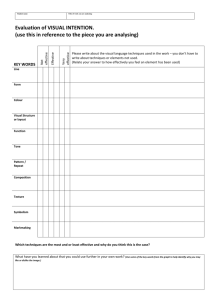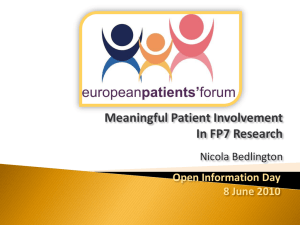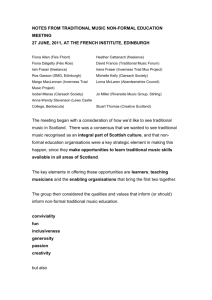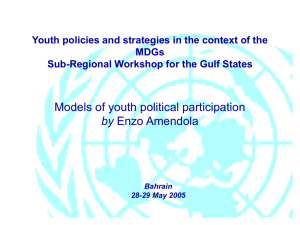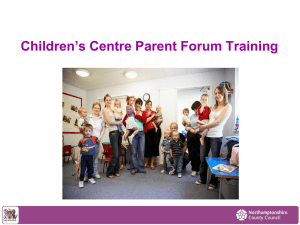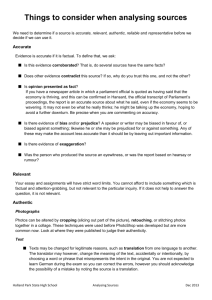Significant Event Analysis (SEA)
advertisement
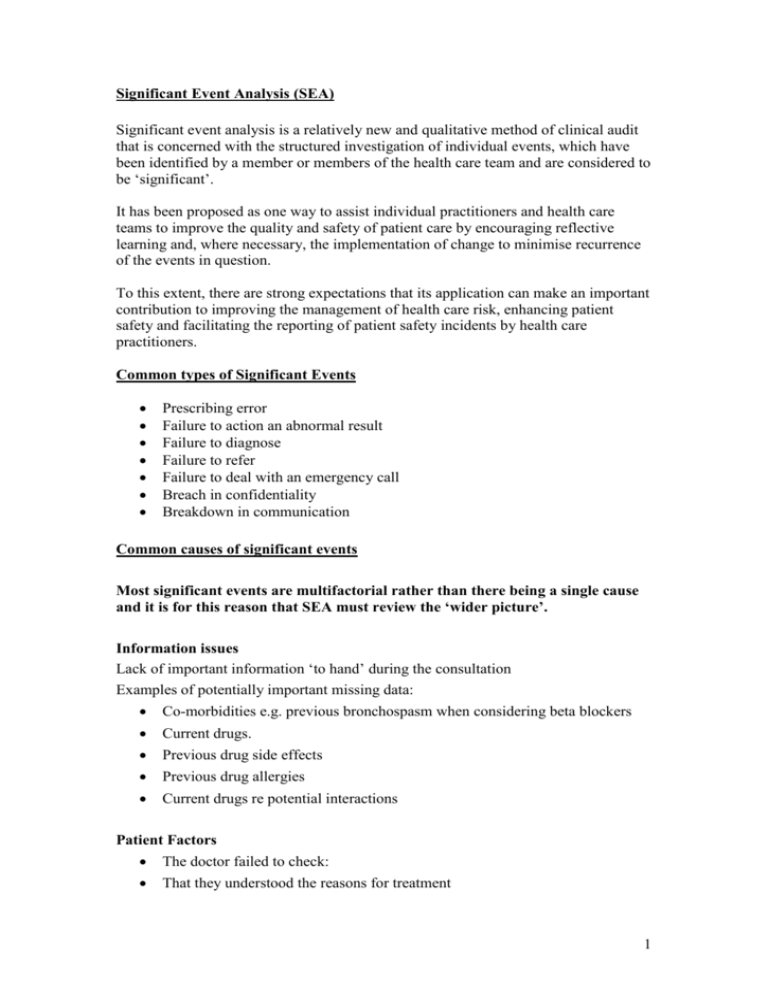
Significant Event Analysis (SEA) Significant event analysis is a relatively new and qualitative method of clinical audit that is concerned with the structured investigation of individual events, which have been identified by a member or members of the health care team and are considered to be ‘significant’. It has been proposed as one way to assist individual practitioners and health care teams to improve the quality and safety of patient care by encouraging reflective learning and, where necessary, the implementation of change to minimise recurrence of the events in question. To this extent, there are strong expectations that its application can make an important contribution to improving the management of health care risk, enhancing patient safety and facilitating the reporting of patient safety incidents by health care practitioners. Common types of Significant Events Prescribing error Failure to action an abnormal result Failure to diagnose Failure to refer Failure to deal with an emergency call Breach in confidentiality Breakdown in communication Common causes of significant events Most significant events are multifactorial rather than there being a single cause and it is for this reason that SEA must review the ‘wider picture’. Information issues Lack of important information ‘to hand’ during the consultation Examples of potentially important missing data: Co-morbidities e.g. previous bronchospasm when considering beta blockers Current drugs. Previous drug side effects Previous drug allergies Current drugs re potential interactions Patient Factors The doctor failed to check: That they understood the reasons for treatment 1 They understood the dosing, timing, stop and start dates They understood the safety-netting guidance The possible side effects GP factors Poor communication skills Lack of medical knowledge or skills Unable to identify the limit of their competence Simple mistakes due to; pressure of time, unnecessary interruptions, poor emotional housekeeping etc. Systems failure Lack of education and training Lack of supervision Poor identification of roles and responsibilities Lack of detailed procedures, protocols etc Lack of audit or SEA Ethos of the practice Seven steps to analysing a significant event STEP ONE Identify and record significant events for analysis and highlight these at a suitable forum e.g. dedicated SEA or team meetings. Enable staff to routinely record significant events using a log book or a special pro-forma. STEP TWO Collect and collate as much factual information as possible for an event including written & electronic records, and the thoughts and opinions of those directly and indirectly involved in the event. This may include patients or relatives or health care professionals based outside the practice. STEP THREE Convene a meeting to discuss and analyse the event(s) with all relevant members of the team. The meeting should be conducted in an open, fair, honest and nonthreatening atmosphere. A note of the meeting should be taken and circulated. Meetings should be held routinely, perhaps as part of monthly team meetings, when all events of interest can be highlighted, discussed, and analysed with all relevant people present and with the opportunity for others to offer their thoughts and suggestions. However, for some practices, the dynamic in this forum may not be conducive to analysing significant events, and it may be more productive to hold dedicated meetings. 2 The person you choose to facilitate a significant event meeting or to take responsibility for an event analysis again depends on practice dynamics and staff confidence. One suggestion is for the individual with the greatest knowledge of the event to assume this role if they are happy to do this. This may be straightforward for many experienced medical staff, but daunting for other members of the practice. The practice manager could facilitate the process initially, especially for administrative events, and then support and encourage other staff to take charge of future analyses. It may also be an idea for some purely clinical significant events to be discussed amongst the clinical staff only as these may not be of direct interest to the rest of the practice team. STEP FOUR Undertake a structured analysis of the significant event. The focus of the meeting should be on establishing exactly what happened and why it happened, with the main emphasis being on learning from the event and changing behaviours, practices, or systems, where appropriate. If this is the case, the purpose of the analysis is to minimise or prevent the chances of the event recurring. One method we suggest of analysing a significant event in a structured manner is by answering in-depth the following four questions: What happened? Gather all the facts relating to the significant event (including relevant dates, times, and people or organisations involved) from those directly and indirectly involved, so you can establish a clear and full picture of what happened. It is important to also consider what the impact or potential impact was for the patient, the team and/or others. You should gather as much of this information as possible before the event is discussed at the meeting. But time and staff availability are factors here, and it's not always immediately clear why an event happened, so you may need to tease this out at the meeting. Why did it happen? At the meeting, establish all of the main and underlying reasons why the event occurred. Consider, for instance, the professionalism of the team, the lack of a practice system or a failing in an existing system, lack of knowledge or the complexity associated with the event. What have you learnt? Highlight any learning issues you and/or the practice experience. You should be able to demonstrate that reflection and learning have taken place on an individual or team basis. For example, it may be related to a training need or to personal learning issues concerned with therapeutics, disease management, or administrative procedures. It could also reflect a learning experience (good or bad) in dealing with patients, colleagues, or other organisations. 3 What have you changed? With many significant events, you will need to make a change to improve the provision of care or minimise the risk that a similar event will occur, or both. Consider, for instance, if an existing protocol needs to be updated or a new one developed, or if members of staff require additional training. If so, you need to ensure that affirmative action is to be taken rather than simply discussing what changes you would like to see implemented or documenting a wish list of actions that have no real prospect of being carried out. A member of staff should be designated to lead on the change and report back on progress at future meetings. On some occasions it may not be possible to implement change. For example, the likelihood of the event happening again may be very small, or change may be out of your control. If so, clearly document why you have not taken action. STEP FIVE Monitor progress of all actions that are agreed and implemented by the team. For example, if the head receptionist agrees to design and introduce a new protocol for taking telephone messages then progress on this new practice development should be reported back as an agenda item at a future meeting. STEP SIX Write-up the event analysis once change has been agreed and implemented. This provides documentary evidence that the event has been dealt with. It is good practice to attach any additional evidence (e.g. a copy of a letter or an amended protocol) to the report. The report should be written-up by the individual who has the greatest knowledge of the event or who led on the event analysis. We suggest the following report template based on the aforementioned approach for a structured event analysis: Date of event. Date of meeting. Lead investigator. 1. What happened? 2. Why did it happen? 3. What has been learned? 4. What has been changed? Remember, the report should reflect an in-depth analysis of each of these areas rather than a superficial attempt to simply describe the event. It is good practice to keep the report anonymous so that individuals and other organisations cannot be identified. STEP SEVEN Seek educational feedback on the standard of the event analysis undertaken once it has been written-up. This is because research has repeatedly shown that around one third of event analyses are considered to be unsatisfactory, mainly because the team has failed to fully understand why the event happened or failed to take necessary or appropriate action to prevent recurrence. By sharing the event analysis with others such as a GP Appraiser, a GP Trainers’ Group, a Practice Managers’ Forum, or a Clinical Governance Lead this provides an opportunity for them to comment on your event analysis and also learn from what you 4 done. Alternatively, you or other colleagues may wish to apply a structured SEA peer review and feedback instrument as a way of reflecting on the ‘quality’ of your written event analysis. 5
